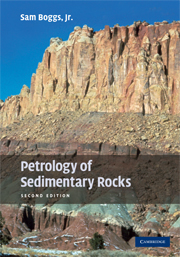Book contents
- Frontmatter
- Contents
- Preface
- Part I Principles
- Part II Siliciclastic sedimentary rocks
- Chapter 2 Sedimentary textures
- Chapter 3 Sedimentary structures
- Chapter 4 Sandstones
- Chapter 5 Conglomerates
- Chapter 6 Mudstones and shales
- Chapter 7 Provenance of siliciclastic sedimentary rocks
- Chapter 8 Diagenesis of sandstones and shales
- Part III Carbonate sedimentary rocks
- Part IV Other chemical/biochemical sedimentary rocks and carbonaceous sedimentary rocks
- References
- Index
- References
Chapter 7 - Provenance of siliciclastic sedimentary rocks
from Part II - Siliciclastic sedimentary rocks
Published online by Cambridge University Press: 05 June 2012
- Frontmatter
- Contents
- Preface
- Part I Principles
- Part II Siliciclastic sedimentary rocks
- Chapter 2 Sedimentary textures
- Chapter 3 Sedimentary structures
- Chapter 4 Sandstones
- Chapter 5 Conglomerates
- Chapter 6 Mudstones and shales
- Chapter 7 Provenance of siliciclastic sedimentary rocks
- Chapter 8 Diagenesis of sandstones and shales
- Part III Carbonate sedimentary rocks
- Part IV Other chemical/biochemical sedimentary rocks and carbonaceous sedimentary rocks
- References
- Index
- References
Summary
Introduction
In the preceding chapters, I characterized sedimentary rocks in terms of their physical and chemical properties. Such characterization is not, however, the principal reason that we normally undertake research on sedimentary rocks. Determining the physical and chemical properties of these rocks is simply a means to a more important end, which is to reconstruct the history of the rocks. Our ultimate aim in studying siliciclastic sedimentary rocks is to develop a fuller understanding of (1) the source(s) of the particles that make up the rocks, (2) the erosion and transport mechanisms that moved the particles from source areas to depositional sites, (3) the depositional setting and depositional processes responsible for sedimentation of the particles (the depositional environment), and (4) the physical and chemical conditions of the burial environment and the diagenetic changes that occur in siliciclastic sediment during burial and uplift. These objectives, in turn, are important to the broader goal of developing reliable paleogeographic models of Earth for particular times in the past. Some studies have a further purpose of evaluating siliciclastic sedimentary rocks in terms of their economic potential as reservoir rocks for oil and gas, source beds for petroleum, host rocks for ore mineralization, groundwater aquifers, and so on.
In this chapter, we deal with one of these important objectives of geologic research, understanding the sources of siliciclastic sediment. We commonly refer to sediment source as provenance. The term provenance is derived from the French provenir, meaning to originate or come forth (Pettijohn et al., 1987, p. 254).
- Type
- Chapter
- Information
- Petrology of Sedimentary Rocks , pp. 220 - 267Publisher: Cambridge University PressPrint publication year: 2009
References
- 3
- Cited by



